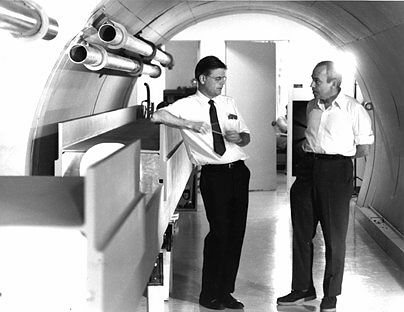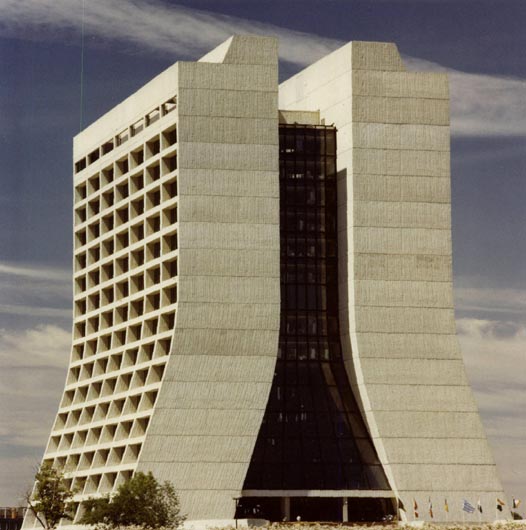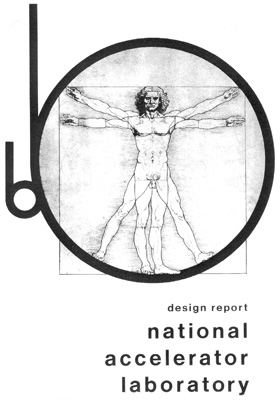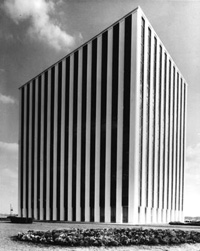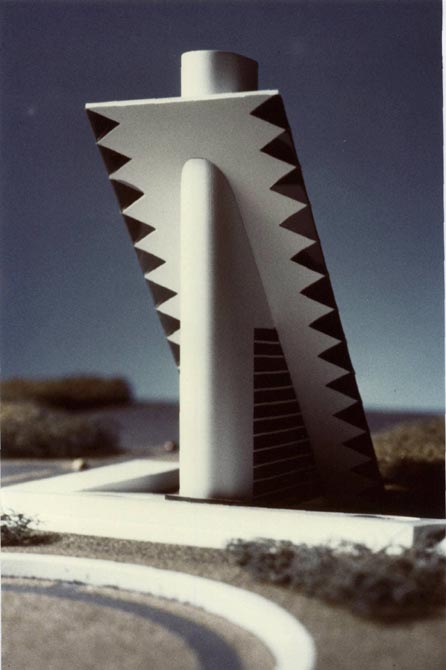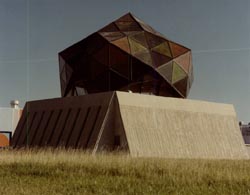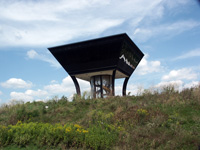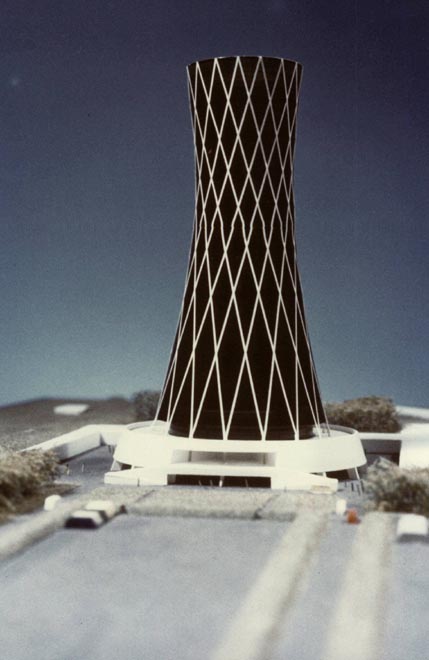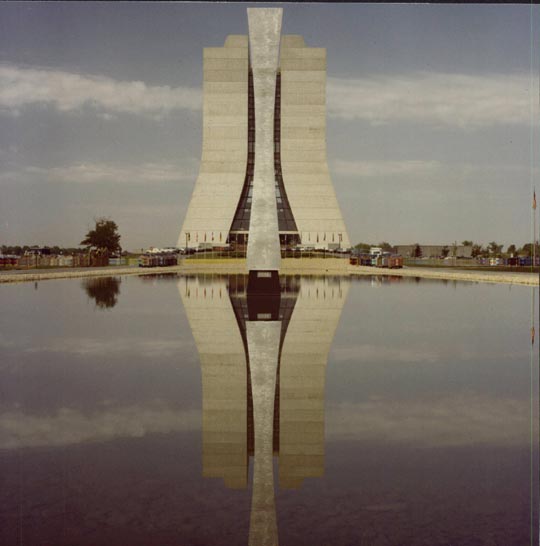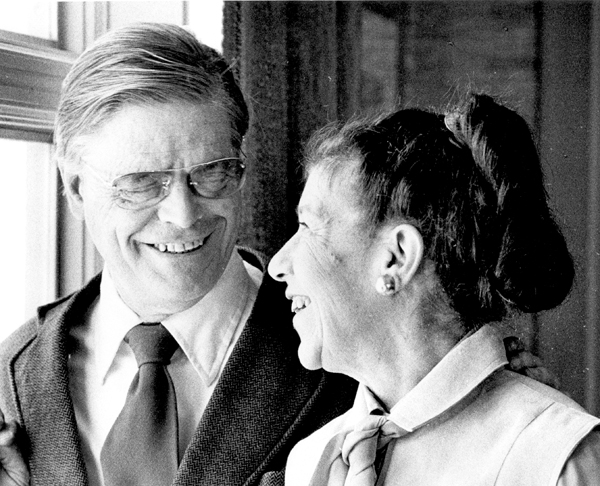Vignettes of Fermilab History: Remarks Made at the Robert R. Wilson Celebration
I was pleased when Jim Cronin asked me if I would say a few words this evening because I have never before been able to talk at Fermilab, about Fermilab, and about Bob in any context except as Bob's Deputy Director. I was always very circumspect in that capacity but now I have my chance to tell it to you like it was. I didn't know when I agreed to talk that Bob would have a chance to rebut.
My time with Bob started in earnest in 1965 on the URA Board of Trustees. Our years together were the Fermilab years, and they were the most important years in the lives of many of us in this room.
An accelerator laboratory is a complicated place. Many people with a variety of skills are required to conceive it, to construct it, to run it and to get physics from it. At Fermilab, there is not one of those varied facets which does not reflect Bob's personal touch and inspiration. Today most of you have experienced first hand some of the more striking examples of that touch. Leon gave you a glimpse of beautiful physics which has been done here. You have sat in an auditorium, pure Wilson, which is surely an unusual facility for a laboratory of this kind. If I can be stopped in time you may have a chance to hear some beautiful music in that auditorium, a program typical of many which have enriched the culture, not only of the Laboratory but also of the surrounding communities. You may have seen the art exhibit on the floor above us and you must certainly have noticed Bob's own sculptures in the reflecting pond out front and on the roof of the auditorium.
Most of all you have experienced this building. Now I must confess that its open planning was the source of a good deal of contention among the staff. There is probably a small pool of blood to be found near every partition that was erected, and near every door that was installed in Bob's time. And through it all Bob deftly maintained a position that was so obscure that no one could tell whether he was the person who had dictated open planning or whether he was fighting against it, tooth and nail, in a losing cause. I'll leave it to you to guess where the truth lies. The fact is that this building is something special. It's not a barrack; it's not part of a technical shopping center. It does not feel like a factory. It is an inspired and an inspiring structure whose quality uplifts the spirit of those who work here and of those who visit.
But you've seen it and you know it. Therefore what can I add?
I shall only mention in passing that construction was completed on a schedule which the experts all agreed was irresponsibly optimistic; the energy was stretched from 200 GeV to 400 GeV and even has touched 500 GeV all within the allotted budget which all the experts said was too little to build even to 200 GeV. As a matter of fact Bob even returned construction dollars to the government and still managed to include a capability to install a 1000 GeV Energy Doubler, which is now being built. I shall also pass over the contributions to physics, rising total cross section of π+, π-, k+, k-, p-; verification of the rising neutrino cross-section, observation of neutrino produced multi-lepton final states, discovery of a charmed baryon, discovery of the upsilon, confirmation of the existence of another quark, and many others.
All of those results represent remarkable accomplishments by many people, but each also hinged on many of Bob's accomplishments and judgment. What I have decided I can do this evening in the short time that I have is to tell some of you and remind others of some of the little things which, taken altogether, perhaps tell more about Fermilab and more about Bob than the big events that are all-too-well known.
I remember the first time Bob took the Energy Doubler idea to the AEC. He later lamented to me that all his life he had been dreaming up crazy, unrealistic schemes and, luckily, no one had taken him seriously. Now, with Fermilab well along the road to success, no sooner did he open his mouth with a really insane idea than everyone accepted it as a reality. Now he would have to make it come true. It is coming true.
Let me remind you that the Fermilab property was 6800 acres of farm land and included the small village of Weston before the State of Illinois took it over and gave it to the Federal government. It took somewhat of a miracle to bring many of the country's best physicists and engineers to this flat piece of farmland and to create some of the wonders of science here. Bob's leadership accomplished that.
At the start, to serve our immediate needs, while the State was in the process of taking the land, the AEC had chosen an abandoned store in a decaying part of a small town called Addison, not very directly connected either to O'Hare Airport from where many of our consultants were to come, nor to the new laboratory site to which a steady stream of traffic would have to develop.
That was one of many points of decision where Bob put his foot down, and one of the few times he argued for a more expensive solution to a problem. He insisted that convenience and morale were both going to be crucial factors during the early, uncertain months of the National Accelerator Laboratory. He firmly held out for quarters on the 10th floor of a building, the Executive Plaza, untypical of Bob both in name and in style. But it worked and it was a tremendously important decision.
The next time Bob served notice that his taste was not to be toyed with was only a few months later; in October 1967 we were preparing to submit our design study report to the AEC and to Congress. Thinking about that occasion, last night, reminded me of a lovely quotation I heard just yesterday, at an Einstein Memorial session in Washington. It is a quote from Herman Marx who attributes it to a recollection of a conversation he once had with Einstein. Einstein asked, "Do you know the difference between a theory and an experiment? A theory is a piece of work which no one believes but the author. An experiment is a piece of work which everyone believes except the author." That is the quote, but in remembering our design report I couldn't help thinking of a third statement of fundamental truth.
- "A proposal is a piece of work which no one believes, neither those who propose it nor those who receive it."
Only Bob believed it.
In any case as we prepared to submit our design report the perennial problem of a cover arose. Bob, as always with help from Angela Gonzales, chose a familiar sketch by Leonardo da Vinci, modifying the original frame around the figure of a man to correspond to the form of the new accelerator design. The man was nude.
The furor that followed should remind us of how quickly our apparently cumbersome and inertial society can change. Today no one could possibly raise an eyebrow at that book cover. Even in 1967 it was almost a cliche artistically, yet for weeks the phone was jangling with calls from the AEC high energy physics group, the Director of the Division of Research, and finally from Commission members themselves. The nude man would make trouble. The word was "Of course I don't mind, but you don't know Senator X. It might scuttle the whole project." The more they called and the higher the office from which the call came, the more firmly Bob dug in. Finally a compromise was struck. Bob agreed (most untypically) to let the local AEC pretend that, although the report was ready, the cover had not yet come from the printer. Therefore we sent, for the AEC's use in Congress, 50 copies without covers. From then on the cover was attached to all copies, as drawn by Leonardo, although it was seriously suggested that we should emasculate the man, so as not to offend anyone's sensibilities.
One important part of Bob's style is to build gradually and learn as you go. He does not presume to freeze a design before he has tried it out. One of the essential precursors to the evolution of construction is a model -- many models in fact. Now models cost money, particularly full scale models, but they also can save money. I remember one case in particular.
There was a great controversy about how large the accelerator tunnel should be. Bob had designed small magnets and he felt that they could be comfortably housed in a tunnel 10' wide. Experts elsewhere felt that 14'-16' was minimal. So Bob went to DUSAF's model builder, Jose Poces, who has stayed with the Lab ever since, and asked him to build a full scale 12' section of tunnel in our quarters in the Oak Brook Executive Plaza and to build full scale model magnets and put them inside. He then invited the experts to come for a showing. They walked through the model, turned to Bob and honestly confessed, "It's too big." The size was reduced to Bob's original plan.
There were other questions associated with the aesthetics and the architecture of the site. When Bob was negotiating with AEC about accepting the Directorship he had made it clear that aesthetics would be a serious consideration to him. He insisted that a special allowance of a few percent of "normal" construction costs must be allowed to him, essentially unquestioned, for the purpose of making the construction beautiful. Now, of course, he rarely, if ever, called in the chips on that bargain. He did insist on good architecture but he did not let it cost more.
In designing this building, for example, he scheduled an "architecture month" during which each of the four companies which formed our joint venturing architect-engineering firm, DUSAF, exhorted their architects to do their best to come up with striking and beautiful designs. Bob then scheduled a day when all of the competitors' designs were displayed, explained, and reviewed. Some were interesting, some were ridiculous, one or two might even have worked. After the review session, Bob polled the staff, and a circular building was chosen.
Then for the next couple of months nothing much happened. We were spending money to build the accelerator, not the building. Meanwhile, back at the Directorate, Bob had sporadic sessions with Parke Rohrer, the head of the DUSAF group, and Alan Ryder, a talented young architect from one of the firms that was not supposed to be doing the architecture. From those conversations sprung this building design. Furthermore, although the special allowance for beauty had been committed, the first thing Bob did was to ask DUSAF to do a rough cost estimate of the plainest, simplest building that would provide the requisite amount of space. Throughout the development of the design of this building the cost of that plain one was used as a measure.
No detail of the Laboratory was too small to capture Bob's attention. Architects are used to serving people who are not architects and who know it. Such clients placidly accept what architects tell them about design and cost, because they don't know better and they don't have the courage to challenge the gospel. Not Bob. He may not be an architect but he certainly does not know it. And furthermore, he never lacks the courage of his convictions. It was a real education for DUSAF and for the subcontractors to find themselves up against a man who would literally tear up their sketches and send them back to the drawing board when they were not pleasing in form or in cost. At first they were horrified, insulted, and frustrated. After a while they actually came to enjoy it.
Even subcontractors often felt Bob's commitment to his convictions. You have probably noticed that the concrete structure of his building has a rather special texture. It has a finish which, although I must confess it's a fake, indicates that it was shaped by forms of haphazardly assembled wooden boards. As a test DUSAF had the subcontractors form and pour the first major structural column, for the basement. The column was about 20 feet high, 10 feet wide and perhaps 3 feet thick -- a massive piece of reinforced concrete. Bob came down to inspect it when the forms were removed. After ten minutes of careful thought he ordered it to be knocked down and done again; It wasn't really all that bad, but with that simple, brash and gutsy decision Bob not only got a better column; he also delivered an unforgettable message that less than the best quality of work was not going to get by.
There are many other stories about buildings but I'll only quickly remind you of one more. The building in which the bubble chamber was to be built had to house a large circular crane. One way of doing that was to have a domed roof. DUSAF designed such a building but the dome was ugly and the cost of the dome was greater than the cost of the rest of the building. Bob threw out the dome design and told DUSAF to build the base of the building and to leave the dome to him. Within the next few weeks one of our engineers came up with an idea for a new building material -- a sandwich of thin plastic sheets with a filling of close packed metal cylinders which were simply empty beer cans and soft drink cans The material worked and triangles ten feet on a side were made of colored plastic. Those were fitted together in a metal frame designed by our chief engineer, Hank Hinterberger, in consultation with Bob, and the structure became, literally, one of the jewels of the site.
Enough about buildings. I'd like to tell you a little bit about scheduling and costs because those are two of Bob's special touches. I'll take some liberties here.
The normal way of scheduling a large project is to study all of its interlocking and interacting pieces, set realistic, conservative times for the completion of each piece, put it all on a computer which places everything in its proper order and comes out with a grand total. Then add 20% for contingencies and you have a schedule. Sometimes it's called PERT.
Now I won't attribute my version of Bob's philosophy to him, because he's never said it this way and it wouldn't have worked if he had. Therefore what I'm now going to describe is my view of his philosophy. In that context Bob believes that no one will ever beat a written schedule. Once the staff sees that a project is to be completed in the year X, even if they could get their part of the job done two years earlier, they will decide to do it better, since they have until X to finish. Add that effect up over thousands of component jobs, and a number of groups do their parts too well. They cost more and they take longer. $100 million become $150 million and year X becomes the year X+2.
Bob chooses another approach. With his experience, his intuition and his gut-feeling, he arrives at a barely conceivable fast schedule, for example completion in the year X-4. Then instead of adding a contingency he subtracts six months to make it just a little impossible. Then he rationalizes it, persuades himself that it is possible, enthuses about it, convinces others that it could be done and it becomes a demanding challenge for everyone. People call on ingenuities they never believed they had. They cut corners, they save time, and time is really money.
Now this system is not without its own cost -- not in money but in other less tangible things. Expectations are raised, not only those of the staff but those of the clients in this case the user community. Bob's date of X-4 is really impossible, but because people have been breaking their necks to make it, X-2 becomes real. in some people's books that's a disaster and a failure. "X-4 is what you promised us and you didn't deliver until X-2." But the tangible reality is that the job is thus done in the year X-2, not X-4, not even X+2:
I remember one piece of apparent scheduling nonsense Bob indulged in when main ring construction was first started. The contractor was slogging around in the mud trying to dig a trench and to pour concrete slabs for the floor of the tunnel. Our physicists, engineers and technicians in the Laboratory's magnet factory were learning how to assemble main ring magnets. One was finally assembled. Now whatever Bob may have said to the contrary that magnet was never going to pass the tests required for service in the ring. Nevertheless Bob told the contractor that our magnet production line was not functioning. We had the first magnet and we had to start installing magnets in the tunnel. We were not providing for an intermediate storage place. So the contractor sped up the work. He completed and cleaned up a section of the tunnel. There was no normal vehicle access road, only a pit. So another contractor trundled over a crane and the first magnet was lowered into the pit and rigged into the tunnel. Utterly ridiculous? Perhaps. But both the contractor and the magnet factory got a big shot in the arm from that operation, and the work of both went faster.
Business practices also received their share of Bob's attention. He was always searching for ways to put the useful aspects of competitive free private enterprise to work for us, for low cost and for fast work. He would typically farm out 1/3 of a job to one company, 1/3 to another and tell both that the last third would go to the one who got the first job done fastest and cheapest. There were many other tricks.
This morning Hans Bethe suggested that a lesson that each of us should learn from Bob Wilson is that of being ready to make mistakes. He went on to talk about the self destructive tendency of our society to seek no-risk solutions to difficult problems. I could not agree with him more on either of those suggestions. I have already described one decision with which Bob reduced the size of the tunnel to something far below the minimum which the experts originally felt was acceptable. It could have been a disaster! In fact, it worked! -- and it saved millions of dollars! Let me remind you of two other instances where Bob took very difficult and unpopular decisions, representing his readiness to risk a mistake, but in fact constituting two of the greatest moneysaving decisions which were made in the course of the construction of the Laboratory.
One concerned the support for the accelerator tunnel. Tradition in accelerator construction was that accelerator structures should be supported on bedrock. Lots of calcula tions showed that, if portions of the accelerator shifted, even by a few hairsbreadth, it would compromise the operation of the machine until corrective action could be taken. Given a four-mile circumference tunnel, it seemed obvious to all the experts that in order to maintain the required tolerances, the tunnel should rest on bedrock. To do that near Batavia, Illinois, would require that concrete pylons be poured to a depth of about 100 feet where bedrock lies in this region. The cost would have been tremendous.
Bob talked with soil engineers and with people who had experience with structures built on slabs poured on the ground in this region. Indications were that the material between ground level and bedrock consisted of a few feet of topsoil, at the surface, and then many feet of "glacial till" beneath the topsoil and extending to the surface of the bedrock. That glacial till had been compressed under the weight of a glacier for many years and might be a very firm and stable foundation. Some small scale tests were made, but the experts were quick to point out that no practical test could measure what would happen over a period of years under the large weight of the real accelerator and its shielding.
Bob made the decision to build the accelerator in the glacial till, without support from bedrock. He conjured up all sorts of Rube Goldberg devices which could, if necessary, compensate for the motion which everyone was afraid might occur. In fact, though, those devices were never needed. The tunnel slab is an extremely stable structure, and the machine has never suffered from small motions. It even continued operation smoothly through one of the rare earthquakes which occur here in northern Illinois.
Another major decision that Bob made was an outright commitment to the making of errors. In that case it concerned the question of degree to which the Laboratory should check the work of the architect-engineering firm to which it contracted the job of designing, engineering and managing the construction of the conventional structures of the Laboratory. Normal AEC practice was that when a laboratory contracted with such an architect-engineering firm it also established a Construction Division of its own. The purpose of such a Construction Division was to review all of the designs and drawings and blueprints produced by the architect-engineering firm, to study them for mistakes or interferences and to redraw under the name and logo of the laboratory instead of under the name and logo of the architect-engineering firm.
Bob felt that such a practice was wasteful of time, effort and money. He also believed that the establishment of a large Construction Division in a laboratory was something that was easy to do but difficult to undo. If such a Division were created, it would be likely to be large and to have a life as long as that of the laboratory. He therefore took the position that we would establish no such Construction Division. Instead, it would be his policy to be highly selective in choosing an architect-engineering firm and to retain an unusual degree of authority over the selection of personnel in the upper management of that firm.
Given the careful selection, and given that degree of control, he felt that we would truly delegate responsibility for architecture, design and construction management to the outside firm. The philosophy was that, if they recognized that the responsibility was really theirs, and not one which would be continually checked and second-guessed by another group in the laboratory, they would take their own work that much more seriously and would perform their job just that much better. Given that fact, Bob believed that it would be far cheaper to accept the mistakes which DUSAF would be bound to make along the way and to correct them after they were made rather than to attempt to avoid making any mistakes by checking, rechecking and re-rechecking every piece of work that was done.
There is no question in my mind but that large savings were made by adopting that philosophy, the very one upon which Hans Bethe was commenting this morning. DUSAF did a magnificent job. They actually felt as if they were a part of the Laboratory organization instead of an outside contractor working for the Laboratory. Furthermore, it was only when DUSAF finally dissolved and disappeared from the scene that the Laboratory began to form an extremely small construction group of its own.
There are many other superficially irrelevant Wilsonisms. Bob grew up in Wyoming. Perhaps many of his contributions to this Laboratory reflect that fact. Certainly the herd of buffalo has roots in Wyoming. And it fell to a city boy like me to rationalize those buffalo to the AEC. Bob wasn't about to give them up anyway.
Then there is the prairie project nurtured by Rene and Tony Donaldson but spawned in Wyoming. For those of you who are not familiar with that project, a restored prairie is rapidly taking over the center of the main ring accelerator. When Bob conferred with the Morton Arboretum prairie expert about the schedule for the project, he was asked how soon we could turn over the land, how soon we could get volunteers to gather seeds, how soon we could burn over the first plot of land and so forth. In characteristic form, Bob's answer to each of those questions was "Immediately." The expert's face became brighter and brighter. Then he sat back happy and said, "Well then I think we can get it done in about 200 years!" Bob couldn't beat that schedule before he left as Director. Maybe Leon will.
Equal opportunity and affirmative action have been important considerations at this Laboratory since 1967. In 1967 there was only the U.S. Constitution, two hundred years of racial problems, country that was uneasy and cities that were burning. Affirmative action policies were not yet required, statements not needed. Yet Bob had a firm idea about the ethics and the demands of the situation. He realized that it was important to identify ourselves publicly with the aggressive practices: that he intended to adopt. This Laboratory's premature affirmative action statement became a model for the AEC and many other agencies when such affirmations became a requirement. In part it reads:
- "In any conflict between technical expediency and human rights we shall stand firmly on the side of human rights. This stand is taken because of, rather than in spite of, a dedication to science. However, such a conflict should never arise. Our support of the rights of members of minority groups in our Laboratory and in its environs is inextricably intertwined with our goal of creating a new center of technical and scientific excellence. The latter cannot be achieved unless we are successful in the former."
Finally let me mention Bob's conviction that in this day and age, problems of physics, as well as many other problems of the world, are too hard, intrinsically, to make them harder by working on them in isolation. In fact he has always felt that both the work and the world would benefit if all people would join together to learn more about nature. So from the very start he saw this Laboratory as an international facility. For several years it was to have unique capabilities, and he felt they should be available to qualified scientists from anywhere.
You have probably noticed the twenty odd flags flying out front. Each represents a country whose scientists have been active at this Laboratory. Leon lamented about that fact this morning. There are no longer enough flagpoles to fly all the flags at once. But don't imagine that it was trivial to establish the principle of open access.
The AEC and the Congress had just passed through a long series of contortions in approving construction of this quarter of a billion dollar facility. There were those who questioned the notion that we should make it available to foreigners at all. And of course the idea of participation by the USSR raised special doubts as US-USSR official relations oscillated from warm to cold. Bob stood firm on the principle, but even better than that he made it a reality.
Many U.S. laboratories for many years have worked within an aura of East-West collaboration in science. But I don't believe that any other laboratory, in a period of seven short years, has put it so actively into practice. More than 50 different scientists from the USSR have actively collaborated in experiments during visits of as long as three years. They were often accompanied by wives and children. The people of Fermilab will not soon forget their Russian friends nor will the visitors, on their part, ever forget their years in the United States and at Fermilab. That understanding and good will, which Bob nurtured, may, in a large sense, be more important than much of the physics which has been done here.
More recently it became possible to start a working collaboration with scientists from the People's Republic of China, and a number of them have already started year-long stays. I think I am correct in saying that Fermilab has led this new out-reach program, one in which we are picking up old connections in working with a people who have a tradition far older than this country -- of deep respect for learning and culture. It has certainly been Bob's leadership which stimulated this new exchange and opened a road that had been too long closed.
I've tried to give you a few vignettes of the less-wellknown parts of Fermilab's history. In them I hope that you will find, as I do, a lot of Bob.
We all know that Bob was the right man at the right time for the building of Fermilab. He may have been the only man because Congress wanted more and the Bureau of the Budget said that it had to cost less. There were many scientists who agreed with the Congress but who knew that a minimal facility had to cost more. There were a few who agreed with the Bureau of the Budget and thought that competing national needs required that it cost less -- but then it wouldn't be interesting. Only Bob could and did honestly go to both and agree with both. The Laboratory should do more, and it should cost less. And he said that it could. Without that it might never have happened.
But Bob brought more than himself to Fermilab. Along with him came Jane and without Jane, also, the Lab could not have flourished. To the foreigners, to the visiting users, to the Laboratory's staff and to their spouses, she was always a gracious hostess and a sympathetic ear and, for many, she provided a home-away-from-home.
Fermilab has been a monumental job with high peaks and deep valleys. I, with many of you, have enjoyed the successes of Fermilab and despaired at its less-than-successes. But for me, Fermilab was primarily Bob. It was his ingenuity that ignited it, his genius that shaped it, and his taste and caring that made it bloom. It was his spirit which gave us a rallying point before Congress when Senator Pastore asked,
Senator Pastore: "Is there anything connected with the hopes of this accelerator that in any way involves the security of the country?"
Dr. Wilson: "No sir; I do not believe so."
Senator Pastore: "Nothing at all?"
Dr. Wilson: "Nothing at all."
Senator Pastore: "It has no value in that respect?"
Dr. Wilson: "It only has to do with the respect with which we regard one another, the dignity of men, our love of culture. It has to do with those things. It has to do with, are we good painters, good sculptors, great poets? I mean all the things that we really venerate and honor in our country and are patriotic about. It has nothing to do directly with defending our country except to help make it worth defending."
Jane and Bob gave every bit of themselves for twelve years to make this a great Laboratory. There was engineering, physics, aesthetics and humanity, but most of all there was leadership. It was an experience and a privilege that I shall never forget to work closely with Bob during all those years. Many of you share that feeling with me and all of you who do, know as I do that this occasion, while marking an end to one of Bob's activities, is really a commencement, marking the beginning of the next. None of us know what that will be, least of all Bob, but we all know it will be something important and striking. I offer a toast to it.



